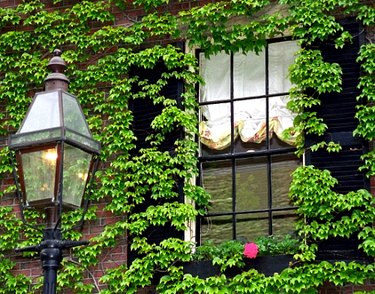
Boston ivy (Parthenocissus tricuspidata) is a perennial vine not native to the U.S., with dark green foliage and small green flowers. It has a long life span and a rapid growth rate, which can make it quickly take over trees and homes, in some cases damaging wood and brick. Getting rid of Boston ivy can be a long process, but with persistence, it's possible to remove the vines permanently.
Getting Rid of Ivy the Natural Way
Video of the Day
To get rid of ivy on trees, cut each and every ivy stem around the tree trunk at around waist height, which should kill the ivy above the cut and cause the leaves to turn brown and then fall off. Use a heavy-duty string trimmer or a pair of garden shears for this process. When the ivy starts to re-grow in the spring, cut off all of the new leaves and growth, not leaving even one leaf to grow. Damage the ivy leaves by crushing handfuls so they split and crack but don't fall off. Be sure to wear gloves. It's possible to pull the ivy off of the trees at any stage, but much easier once you have killed the ivy and it's dried out. Ivy removal is a long-term process you will have to repeat, and may take from three to ten years depending upon the diameter of the stems.
Video of the Day
To remove ivy from buildings, especially brick, first prune it aggressively. Second, use a stiff-blade scraper to remove the part of the vines that remain fastened to the wall. Work slowly and scrape at a low angle to avoid scratching the brick. Wear gloves to protect your hands. Scrub or burn off any remaining plant material with a moderately stiff brush (wire brushes and even very stiff brushes may scratch brick), or use a paint scraper or propane torch to burn it off. One word of caution---if you use a torch, wear goggles and keep the flame well away from wood or cracks. Test in an inconspicuous area first to make sure using the torch won't scorch the masonry. Just like removing ivy from trees, repeat this process for one or two years and allow the ivy to die before attempting to remove it from the brickwork to avoid damaging the brick.
Using Herbicide
Choose an herbicide containing glyphosate, which is harmless to soil but will damage or kill any other plant you spill it on. Brush it onto fresh cuts in the plant stems, spray it, or apply it with a watering can. It's best to use an herbicide when new foliage starts to grow, or in the autumn when the plants are moving sugars down into their roots for the winter and the glyphosate will be transported there. Be patient, as it will take a couple of weeks before you see any progress, and may even take a few applications to kill the ivy. If the ivy is well established, you may need four or more applications over a two-year period.